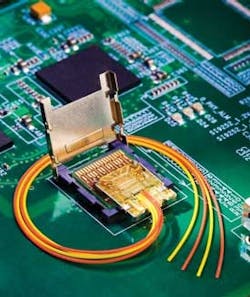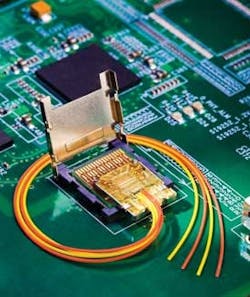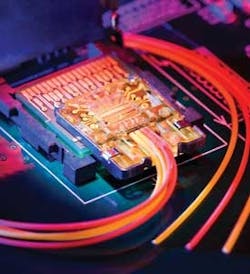Intel plots Light Peak interconnect revolution
By Meghan Fuller Hanna
Intel believes that Light Peak, its high-speed optical interconnect technology, will be integrated within all PCs and consumer electronic devices in the next couple of years, thus catapulting optical technology from the relatively niche telecom market to the mainstream.
Four years ago, Intel started a program, dubbed Light Peak, to develop an optical cable technology designed to connect electronic devices, such as computers, displays, docking stations, disk drives, and peripherals, such as camera and smartphones. Intel’s goal was to replace copper cables, which had reached practical limits in terms of both bandwidth and reach, with an interconnect that provided both high speed (10 Gbps in its initial version with a migration path to 100 Gbps) and support for multiple protocols.
At press time, Intel had conducted three successful public demonstrations of the Light Peak technology and confirmed that the first Light Peak-enabled PCs should begin shipping next year. To say the company is bullish on the technology is an understatement. In his keynote address at the Consumer Electronics Show earlier this year, Intel CEO Paul Otellini called Light Peak “the I/O performance and connection for the next generation,” and confirmed that both Nokia and Sony have publicly announced their support.
Victor Krutul, director of Intel’s optical development team and founder of the Light Peak program, is even more effusive, calling Light Peak “the biggest thing to happen to the optical industry ever, or at least since the creation of the laser.”
The Light Peak optical module shown here supports four fibers, each capable of carrying 10 Gbps of data. In its initial offering, Light Peak will support 10 Gbps, but Intel has mapped a migration path to 100 Gbps.
As with any new technology, predicting adoption rates is difficult at best. And Intel still has at least one big challenge to overcome: determining the best path to standardization. But even if Light Peak does not live up to Intel’s lofty expectations—integration within all PCs and consumer electronic devices over the next few years—the program may pave the way for future applications of optical technology in the mainstream consumer electronics world.
Not your traditional telecom module
According to Intel, Light Peak provides three key benefits, the first being high bandwidth. The initial version will run at 10 Gbps, but Light Peak has been designed to scale to 100 Gbps. “We’re planning this to be a 10+ years optical interconnect,” notes Krutul.
Today, all interconnects are single protocol; Light Peak, by contrast, will support multiple protocols over one cable, allowing the end user to use one cable to connect any device. Among the protocols Intel plans to support are USB, Display Port (DP), HDMI, and PCI Express. Intel has developed its own controller IC to provide this multi-protocol support.
Finally, Light Peak enables the use of longer, thinner cables; Intel is using optical fibers with an outside diameter of 125 microns. As a result, the two-port optical module itself has a footprint of only 12x12 mm. According to Intel, 120 Light Peak optical modules could fit in the area of one traditional telecom module.
The needs of the consumer electronics market strongly influenced the design of the Light Peak optical module, Krutul says. Intel wanted the ability both to scale to 100 Gbps and to leverage economies of scale and high-volume manufacturing to push optics into the mainstream. There are several ways in which Intel and its suppliers have sought to accomplish this goal.
First, Intel relaxed the optical standards required of its components. In the telecom market, components must meet stringent Telcordia standards, such as a 20-year lifetime. Obviously, that kind of longevity is not required in the PC market, so Intel lowered its requirements to a five- to seven-year lifetime.
Requirements for the operating environment also are not as rigorous. Intel lowered thermal requirements from the Telcordia-specified range of 0° to 85° to a more relaxed 5° to 65°. Krutul notes that Intel had originally intended to specify a range starting at 0° but then realized that batteries freeze at that temperature, making the operation of the PC a moot point.
The company also relaxed its specification for number of failures per lifetime. If you have a failure on a trans-Atlantic cable, Krutul says, it’s a big deal. But the potential failure of one of four ports on a PC, for example, is not nearly as critical.
Because Light Peak is intended for distances of 100 m or less—and dispersion is, therefore, not an issue—spectral-width requirements also can be less stringent than Telcordia specifies. As a result, says Krutul, “We’re finding that vendors are able to get closer to 90% to 95% yields on their VCSELs and photodetectors, rather than the much lower [yields] you see in telecom.”
Intel has also removed the traditional eye-safety requirements, which also translates into higher yields and lower costs. The traditional telecom module is typically launched at about 1 mW of power. Thanks to “very aggressive power management,” the Light Peak optical module features a launch power ”much higher than eye safety,” says Krutul. The Light Peak module detects when cables are cut or unplugged and automatically turns off the laser.
Finally, Intel designed the optical module to be high-volume manufacturable. Intel ships hundreds of millions of CPUs per year using passive assembly, meaning complete assembly and testing without human intervention. The company plans to manufacture the Light Peak optical module in the same fashion. Says Krutul, “The goal is to have one optical module come off the manufacturing line every four seconds.”
According to Intel, 120 Light Peak optical modules, such as the one shown here, can fit in the area of one traditional telecom module. The module measures just 12x12 mm.
This combination of relaxed optical requirements and the ability to manufacture in volume results in an optical module that can cost up to 30 times less than a traditional telecom optical module, Intel claims.
But there is at least one rather large hurdle that Intel must still overcome: How to standardize its new technology. Krutul confirms that Intel does intend to make Light Peak a standard. To that end, the company has spoken with a number of other companies and standards bodies to determine how best to achieve this goal. As Krutul notes, “When you make things a standard, they get adopted more easily and faster.” However, he admits, “we haven’t quite figured out yet how to do it.”
‘A big step in the right direction’
The components, including the connectors, cables, and controller chip, should be available in the latter part of this year, Krutul reports. Obviously, Intel cannot control when its OEMs ship product, he notes, but the company is optimistic that all the necessary components will be available in time to bring Light Peak-enabled PCs to market sometime next year.
Intel’s Light Peak suppliers include:
- Oclaro: VCSELs
- Enablence Technologies Inc.: large-area, dual-wavelength 10-Gbps photodiodes
- Avago Technologies: optical module with embedded optical engine
- SAE Magnetics: optical module
- IPtronics: driver and receiver silicon
- Ensphere Solutions Inc.: transceiver IC
- FOCI Fiber Optic Communications Inc.: connectors and cables.
The suppliers interviewed for this story, including Oclaro, Ensphere Solutions, and Enablence Technologies, could be characterized as cautiously optimistic about Light Peak, but they are unanimous in their enthusiasm for optical interconnect technology, in general. In the words of Yves LeMaitre, executive vice president and division manager at Oclaro, “Whether it’s going to be Light Peak or it’s going to be Light Peak Plus or some other variant, the market will decide. But at the end of the day, this type of technology will be deployed,” he asserts, “and it will be deployed in the hundreds of millions of devices per year because that’s the scale we’re talking about.”
“Moving optics into more of a mainstream, consumer-type application has always been a big goal in the optical community,” adds Matt Pearson, vice president of technology at Enablence. “A big player like Intel is the kind of push that’s been needed...to get the right people together. It is a big, big step in the right direction.”
And the work being done on Light Peak may carry over into other applications, notes Al Gharakhanian, vice president of marketing at Ensphere Solutions Inc. “We believe some barriers have been shattered in terms of the overall cost of the technology and how simple it is to build,” he says, noting that similar technology could be adapted for board-to-board and chip-to-chip interconnect, backplane, and active cable applications. “We have a new business model and a new cost structure to work with, which really helps in terms of making those solutions cost-effective,” he contends.
Meghan Fuller Hanna is senior editor at Lightwave.


